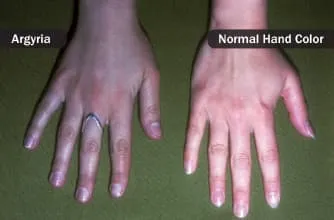Argyria is a rare skin condition that can happen if silver builds up in your body over a long time.
It can turn your skin, eyes, internal organs, nails, and gums a blue-gray color, especially in areas of your body exposed to sunlight. That change in your skin color is permanent.
Symptoms

The discoloration may stand out most on your forehead, nose, hands, and other areas that are exposed to the sun.
The whites of your eyes and nail beds may also turn blue-gray.
Some people's internal organs in their abdomen -- such as the spleen, liver, and intestines -- take on a bluish color, but you wouldn’t know this unless you had surgery.
Causes
You might get argyria if you take dietary supplements that contain silver, use medication such as eyedrops or nose sprays that contain silver, or work where silver particles are in the air.
When you swallow silver, it corrodes in your stomach acid and turns into silver salt, which can travel through your bloodstream and end up in your skin. When exposed to sunlight, the silver salt turns back to silver and colors your skin blue. This is similar to the process silver goes through when used in black-and-white photography.
Colloidal silver. This dietary supplement can cause argyria. It consists of tiny silver particles in a liquid. Makers of these products may claim they boost your immune system and can treat cancer, HIV and AIDS, shingles, herpes, and eye problems, but scientific research doesn’t support that.
The FDA says over-the-counter drugs and supplements containing colloidal silver or silver salts aren’t safe and effective. Silver has no known benefits when swallowed and isn’t essential to the human body.
Some drugs. If you take medication that contains silver for a long time, it can cause argyria. Luckily, those medicines aren’t used as much as they used to be. The following uses of silver are among those that have been shown to cause argyria:
- Silver nitrate used to treat gum bleeding and varicose veins
- Silver sulfadiazine cream used to prevent infection in wounds and burns
- Silver acetate used in lozenges and other products to help quit smoking
- Colloidal silver protein used in eyedrops
On the job. People who work with silver for a long time can get argyria. If you work in silver mining, processing, or manufacturing, or another field that brings you into regular contact with silver, you may breathe in silver particles or they may become lodged in your skin, causing argyria.
Other causes. It’s possible that some people’s genes make them more likely to get argyria.
There have been rare cases of argyria caused by silver-coated acupuncture needles, silver earrings, and dental pieces. But that’s not likely to happen.
Diagnosis
If your doctor thinks you may have argyria, you’ll get a physical exam and answer questions about your history and medications. Tell your doctor about any medications, dietary supplements, or treatments you’ve used that contain silver, and any other exposure to silver.
Your doctor may also do a skin biopsy -- taking a small amount of your skin for testing -- to confirm whether you have argyria.
Treatment
The skin discoloration that argyria causes won’t go away. But sunscreen can help prevent the color from darkening. Makeup can help hide the effects of argyria on your skin.
Using a 5% hydroquinone treatment on your skin may curb the amount of silver in your skin and make it look better.
Laser therapy may also help treat argyria.
Prevention
You can prevent argyria by limiting your use of medications that contain silver and avoiding dietary supplements that contain silver.
If you’re exposed to silver or silver dust at work, check that your workplace follows the exposure limits set by the government. The Occupational Safety and Health Administration (OSHA) and the Mine Safety and Health Administration (MSHA) enforce a limit of 0.01 mg/m3 for metallic and soluble silver compounds.

